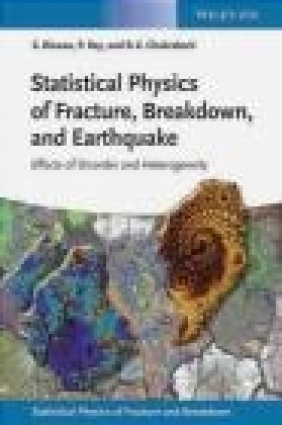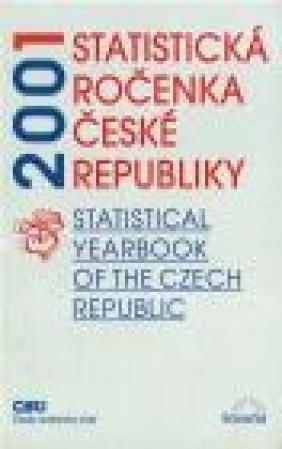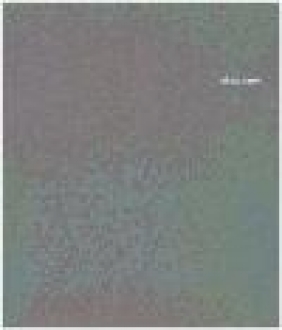Statistical Physics of Fracture, Breakdown and Earthquake
Bikas Chakrabarti, Soumyajyoti Biswas, Purusattam Ray
Statistical Physics of Fracture, Breakdown and Earthquake
Bikas Chakrabarti, Soumyajyoti Biswas, Purusattam Ray
- Producent: Blackwell Verlag GmbH
- Rok produkcji: 2015
- ISBN: 9783527412198
- Ilość stron: 344
- Oprawa: Twarda
Niedostępna
Opis: Statistical Physics of Fracture, Breakdown and Earthquake - Bikas Chakrabarti, Soumyajyoti Biswas, Purusattam Ray
In this book, the authors bring together basic ideas from fracture mechanics and statistical physics, classical theories, simulation and experimental results to make the statistical physics aspects of fracture more accessible. They explain fracture-like phenomena, highlighting the role of disorder and heterogeneity from a statistical physical viewpoint. The role of defects is discussed in brittle and ductile fracture, ductile to brittle transition, fracture dynamics, failure processes with tension as well as compression: experiments, failure of electrical networks, self-organized critical models of earthquake and their extensions to capture the physics of earthquake dynamics. The text also includes a discussion of dynamical transitions in fracture propagation in theory and experiments, as well as an outline of analytical results in fiber bundle model dynamics With its wide scope, in addition to the statistical physics community, the material here is equally accessible to engineers, earth scientists, mechanical engineers, and material scientists. It also serves as a textbook for graduate students and researchers in physics.Series Editors' Preface XIII Preface XV Notations XVII 1 Introduction 1 2 Mechanical and Fracture Properties of Solids 7 2.1 Mechanical Response in Materials 8 2.1.1 Elastic and Plastic Regions 8 2.1.2 Linear Elastic Region 9 2.1.3 Nonlinear Plastic Region 10 2.2 Ductile, Quasi-brittle, and Brittle Materials 11 2.3 Ductile and Brittle Fracture 11 2.3.1 Macroscopic Features of Ductile and Brittle Fractures 12 2.3.2 Microscopic Features of Ductile and Brittle Fractures 14 3 Crystal Defects and Disorder in LatticeModels 17 3.1 Point Defects 17 3.2 Line Defects 18 3.3 Planar Defects 20 3.4 Lattice Defects: PercolationTheory 22 3.5 Summary 25 4 Nucleation and Extreme Statistics in Brittle Fracture 27 4.1 Stress Concentration Around Defect 27 4.1.1 Griffith'sTheory of Crack Nucleation in Brittle Fracture 30 4.2 Strength of Brittle Solids: Extreme Statistics 32 4.2.1 Weibull and Gumbel Statistics 32 4.3 Extreme Statistics in Fiber Bundle Models of Brittle Fracture 34 4.3.1 Fiber Bundle Model 34 4.3.1.1 Strength of the Local Load Sharing Fiber Bundles 35 4.3.1.2 Crossover from Extreme to Self-averaging Statistics in the Model 35 4.4 Extreme Statistics in Percolating Lattice Model of Brittle Fracture 37 4.5 Molecular Dynamics Simulation of Brittle Fracture 39 4.5.1 Comparisons with Griffith's Theory 39 4.5.2 Simulation of Highly Disordered Solids 41 4.6 Summary 42 5 Roughness of Fracture Surfaces 45 5.1 Roughness Properties in Fracture 45 5.1.1 Self-affine Scaling of Fractured Surfaces 46 5.1.2 Out-of-plane Fracture Roughness 47 5.1.3 Distribution of Roughness: Mono- and Multi-affinity 49 5.1.3.1 Nonuniversal Cases 50 5.1.3.2 Anisotropic Scaling 54 5.1.4 In-plane Roughness of Fracture Surfaces 56 5.1.4.1 Waiting Time Distributions in Crack Propagation 60 5.1.5 Effect of Probe Size 62 5.1.6 Effect of Spatial Correlation and Anisotropy 65 5.2 Molecular Dynamics Simulation of Fractured Surface 66 5.3 Summary 68 6 Avalanche Dynamics in Fracture 69 6.1 Probing Failure with Acoustic Emissions 70 6.2 Dynamics of Fiber Bundle Model 74 6.2.1 Dynamics Around Critical Load 77 6.2.2 Dynamics at Critical Load 81 6.2.3 Avalanche Statistics of Energy Emission 81 6.2.4 Precursors of Global Failure in the Model 82 6.2.5 Burst Distribution: Crossover Behavior 84 6.2.6 Abrupt Rupture and Tricritical Point 85 6.2.7 Disorder in Elastic Modulus 87 6.3 Interpolations of Global and Local Load Sharing Fiber Bundle Models 88 6.3.1 Power-law Load Sharing 89 6.3.2 Mixed-mode Load Sharing 90 6.3.3 Heterogeneous Load Sharing 92 6.3.3.1 Dependence on Loading Process 93 6.3.3.2 Results in One Dimension 94 6.3.3.3 Results in Two Dimensions 96 6.3.3.4 Comparison with Mixed Load Sharing Model 101 6.4 RandomThreshold Spring Model 101 6.5 Summary 107 7 Subcritical Failure of Heterogeneous Materials 111 7.1 Time of Failure Due to Creep 111 7.1.1 Fluctuating Load 112 7.1.2 Failure Due to Fatigue in Fiber Bundles 119 7.1.3 Creep Rupture Propagation in Rheological Fiber Bundles 122 7.1.3.1 Modification for Local Load Sharing Scheme 126 7.2 Dynamics of Strain Rate 129 7.3 Summary 134 8 Dynamics of Fracture Front 135 8.1 Driven Fluctuating Line 135 8.1.1 Variation of Universality Class 140 8.1.2 Depinning with Constant Volume 142 8.1.3 Infinite-range Elastic Force with Local Fluctuations 144 8.2 Fracture Front Propagation in Fiber Bundle Models 146 8.2.1 Interfacial Crack Growth in Fiber Bundle Model 146 8.2.2 Crack Front Propagation in Fiber Bundle Models 149 8.2.3 Self-organized Dynamics in Fiber Bundle Model 151 8.3 Hydraulic Fracture 161 8.4 Summary 163 9 Dislocation Dynamics and Ductile Fracture 165 9.1 Nonlinearity in Materials 165 9.2 Deformation by Slip 165 9.2.1 Critical Stress to Create Slip in Perfect Lattice 166 9.3 Slip by Dislocation Motion 167 9.4 Plastic Strain due to Dislocation Motion 169 9.5 When Does a Dislocation Move? 170 9.5.1 DislocationWidth 170 9.5.2 Dependence on Grain Boundaries in Crystals 171 9.5.3 Role of Temperature 171 9.5.4 Effect of Applied Stress 172 9.6 Ductile-Brittle Transition 172 9.6.1 Role of Confining Pressure 172 9.6.2 Role of Temperature 173 9.7 TheoreticalWork on Ductile-Brittle Transition 174 10 Electrical Breakdown Analogy of Fracture 177 10.1 Disordered Fuse Network 178 10.1.1 Dilute Limit (p --> 1) 179 10.1.2 Critical Behavior (p --> pc) 180 10.1.3 Influence of the Sample Size 181 10.1.4 Distribution of the Failure Current 182 10.1.4.1 Dilute Limit (p --> 1) 182 10.1.4.2 At Critical Region (p --> pc) 183 10.1.5 Continuum Model 183 10.1.6 Electromigration 184 10.2 Numerical Simulations of Random Fuse Network 185 10.2.1 Disorders in FailureThresholds 187 10.2.2 Avalanche Size Distribution 188 10.2.3 Roughness of Fracture Surfaces in RFM 191 10.2.4 Effect of High Disorder 193 10.2.5 Size Effect 196 10.3 Dielectric Breakdown Problem 197 10.3.1 Dilute Limit (p --> 1) 198 10.3.2 Close to Critical Point (p --> pc) 199 10.3.3 Influence of Sample Size 199 10.3.4 Distribution of Breakdown Field 200 10.3.5 Continuum Model 200 10.3.6 Shortest Path 201 10.3.7 Numerical Simulations in Dielectric Breakdown 201 10.3.7.1 Stochastic Models 201 10.3.7.2 Deterministic Models 202 10.4 Summary 205 11 Earthquake as Failure Dynamics 207 11.1 Earthquake Statistics: Empirical Laws 207 11.1.1 Universal Scaling Laws 209 11.2 Spring-block Models of Earthquakes 214 11.2.1 Computer Simulation of the Burridge-Knopoff Model 215 11.2.2 Train Model of Earthquake 219 11.2.3 Mapping of Train Model to Sandpile 221 11.2.3.1 Mapping to Sandpile Model 222 11.2.4 Two-fractal Overlap Models 223 11.2.4.1 Model Description 224 11.2.4.2 GR and Omori Laws 225 11.3 Cellular Automata Models of Earthquakes 227 11.3.1 Bak TangWiesenfeld (BTW) Model 228 11.3.2 Zhang Model 232 11.3.3 Manna Model 234 11.3.4 Common Failure Precursor for BTWand Manna Models and FBM 237 11.3.4.1 Precursor in BTWModel 238 11.3.4.2 Precursor in Manna Model 240 11.3.4.3 Precursor in Fiber Bundle Model 240 11.3.5 Olami-Feder-Christensen (OFC) Model 240 11.3.5.1 Moving Boundary 242 11.4 Equivalence of Interface and Train Models 246 11.4.1 Model 248 11.4.2 Avalanche Statistics in Modified Train Model 250 11.4.3 Equivalence with Interface Depinning 253 11.4.4 Interface Propagation and Fluctuation in Bulk 255 11.5 Summary 261 12 Overview and Outlook 265 A Percolation 269 A.1 Critical Exponent: General Examples 269 A.1.1 Scaling Behavior 270 A.2 Percolation Transition 270 A.2.1 Critical Exponents of Percolation Transition 272 A.2.2 Scaling Theory of Percolation Transition 273 A.3 Renormalization Group (RG) Scheme 274 A.3.1 RG for Site Percolation in One Dimension 276 A.3.2 RG for Site Percolation in Two-dimensional Triangular Lattice 278 A.3.3 RG for Bond Percolation in Two-dimensional Square Lattice 279 B Real-space RG for Rigidity Percolation 281 C Fiber Bundle Model 285 C.1 Universality Class of the Model 285 C.1.1 Linearly Increasing Density of Fiber Strength 285 C.1.2 Linearly Decreasing Density of Fiber Strength 286 C.1.3 Nonlinear Stress-Strain Relationship 288 C.2 Brittle to Quasi-brittle Transition and Tricritical Point 290 C.2.1 Abrupt Failure and Tricritical Point 292 D Quantum Breakdown 293 E Fractals 295 F Two-fractal Overlap Model 297 F.1 Renormalization Group Study: Continuum Limit 297 F.2 Discrete Limit 299 F.2.1 Gutenberg-Richter Law 299 F.2.2 Omori Law 300 G Microscopic Theories of Friction 303 G.1 Frenkel-Kontorova Model 303 G.2 Two-chain Model 304 G.2.1 Effect of Fractal Disorder 305 References 309 Index 323
Szczegóły: Statistical Physics of Fracture, Breakdown and Earthquake - Bikas Chakrabarti, Soumyajyoti Biswas, Purusattam Ray
Tytuł: Statistical Physics of Fracture, Breakdown and Earthquake
Autor: Bikas Chakrabarti, Soumyajyoti Biswas, Purusattam Ray
Producent: Blackwell Verlag GmbH
ISBN: 9783527412198
Rok produkcji: 2015
Ilość stron: 344
Oprawa: Twarda
Waga: 0.89 kg






























